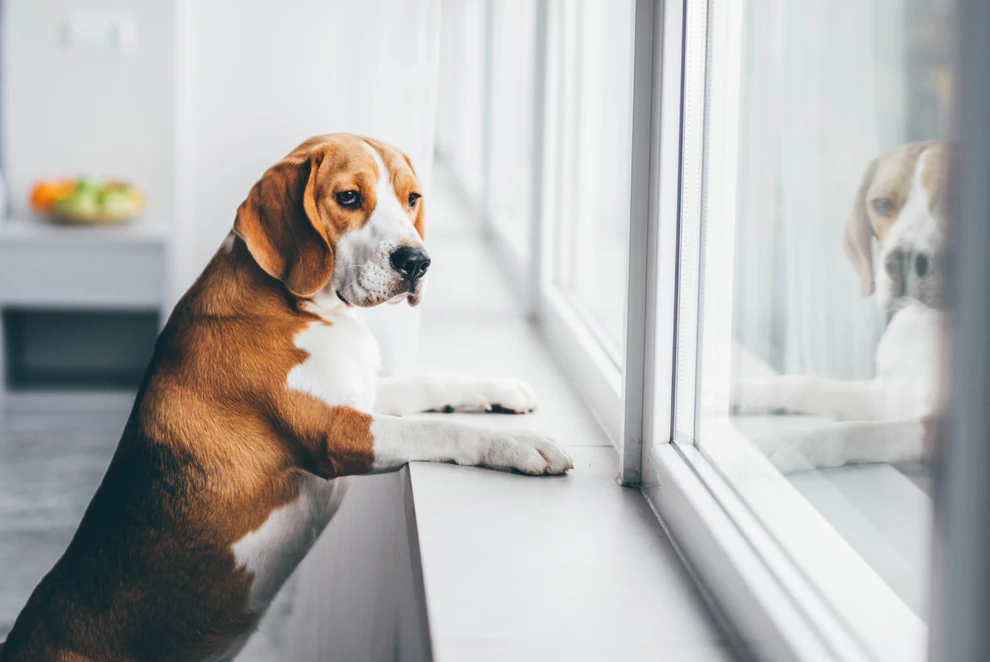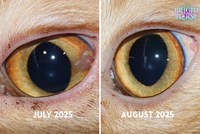What is Separation Anxiety in Dogs?
Separation anxiety is one of the most common behavioural issues in dogs, affecting up to 20-40% of cases seen by animal behaviourists. This condition occurs when a dog experiences significant stress and anxiety when separated from their owner or left alone, even for short periods. Dogs with separation anxiety may display a variety of distressing behaviours, including excessive barking, destructive chewing, house soiling, and attempts to escape.
For owners, dealing with separation anxiety can be incredibly challenging and frustrating. It’s hard to watch a beloved pet suffer each time you leave the house. Separation anxiety not only impacts the dog’s well-being, but it can also strain the human-animal bond and disrupt household routines. In severe cases, this behaviour may lead to dogs being rehomed or surrendered due to the challenges of managing their anxiety.
The good news is that separation anxiety can be managed and even overcome with the right understanding and approach. In this blog, I will explore the symptoms, causes, and effective strategies to help dogs cope with being alone. By applying science-backed techniques and providing compassionate support, you can help your dog feel more secure and confident when they’re on their own.
Signs and Symptoms of Separation Anxiety
Dogs with separation anxiety exhibit a range of behaviours that indicate their distress when left alone or separated from their owners. These signs can vary in severity, but they typically begin the moment a dog anticipates their owner’s departure. Understanding these symptoms is crucial for recognizing separation anxiety and addressing it before it escalates.
One of the most common signs of separation anxiety is continuous barking, howling, or whining shortly after the owner leaves. This vocalization stems from the dog’s attempt to call their owner back or release pent-up anxiety. Dogs with separation anxiety often vocalize non-stop, and the behaviour only subsides when the owner returns.
Destructive behaviours like chewing furniture, scratching doors, or tearing up household items are also frequent indicators of separation anxiety. These behaviours occur as the dog tries to escape or soothe their stress. In some cases, dogs may even injure themselves by attempting to break through doors, windows, or crates. This destruction is not a sign of disobedience but rather a frantic response to extreme anxiety.
Another symptom of separation anxiety is inappropriate elimination, where dogs urinate or defecate indoors despite being house-trained. This typically happens within a short period of the owner’s departure and is directly related to the dog’s anxiety rather than a medical issue or lack of training. Dogs with separation anxiety often cannot control their bladder or bowels when left alone, which can add to an owner’s frustration.
Some dogs with separation anxiety will pace anxiously, moving in fixed patterns (such as back and forth or in circles) around the house. This restlessness reflects their inability to settle down or relax when left alone. While pacing may seem less destructive than other behaviours, it is still a clear sign of distress.
In more extreme cases, dogs may attempt to escape confinement by scratching at doors, chewing through barriers, or breaking out of crates. These attempts to reunite with their owner often result in injuries to the dog, including broken teeth, scraped paws, and other physical harm. Escape behaviours are particularly dangerous and can escalate quickly if the anxiety is left unaddressed.
Many dogs show signs of anxiety even before their owner leaves the house. This “pre-departure anxiety” can include pacing, whining, or becoming unusually clingy as the owner prepares to leave. Dogs often recognize specific cues, such as picking up car keys or putting on a coat, which triggers their anticipatory anxiety.
Recognizing these symptoms is the first step toward addressing separation anxiety. In the next section, we’ll explore the root causes of separation anxiety and why it develops in some dogs but not others.
Understanding Why Separation Anxiety Occurs
Separation anxiety doesn’t appear out of nowhere—it often develops as a response to a combination of environmental, emotional, and genetic factors. Understanding why some dogs develop separation anxiety while others don’t can help owners take proactive steps to manage and reduce this behaviour.
One of the primary causes of separation anxiety is a strong, often unhealthy, attachment to the owner. Dogs that have been overly dependent on their owners for comfort and security may struggle to cope when left alone. This dependence can develop if a dog spends most of their time in close contact with the owner, especially in early stages of life, making it difficult for them to handle even short periods of separation.
Dogs that were not adequately socialized as puppies are more likely to develop separation anxiety as adults. Early socialization teaches dogs how to manage new experiences, including being alone, without fear or stress. Dogs that missed out on this critical period of development—such as those adopted from shelters or rescued from neglectful situations—may be more prone to anxiety and stress when separated from their owners.
Interestingly, dogs may develop separation anxiety when they cannot predict their owner’s departure, which creates a sense of unpredictability and fear. Research suggests that dogs often anticipate their owner leaving the house based on certain cues, like picking up car keys or putting on shoes. When dogs become anxious about these cues, it can trigger a heightened stress response, leading to the development of separation anxiety.
Additionally, contextual fear plays a role, where dogs begin to associate the environment they are left in with the stress of being alone. For example, a dog confined to a specific room when left alone may start associating that room with their anxiety, making them even more fearful each time they’re placed there. This kind of fear builds over time, reinforcing the cycle of anxiety and distress.
Sudden changes in a dog’s routine or traumatic experiences can also trigger separation anxiety. Events like moving to a new home, the loss of a family member, or a change in household dynamics (such as a new baby or pet) can cause dogs to feel insecure and lead to separation-related distress. Dogs that have experienced abandonment, neglect, or multiple rehomings may be more vulnerable to developing separation anxiety, as they may fear being left again.
Some breeds may be more genetically predisposed to developing separation anxiety. While any dog can suffer from this condition, research suggests that certain breeds, particularly those known for their strong attachment to humans—such as Labrador Retrievers, Border Collies, and German Shepherds—may be more prone to anxiety and separation-related behaviours.
In some cases, dogs can develop separation anxiety after learning that their owners’ departure leads to distress. For instance, if a dog has previously been left alone for long periods without proper training, they may begin associating being alone with fear, boredom, or stress. Without positive reinforcement or gradual desensitization, this learned behaviour can become ingrained and worsen over time.
By understanding the various factors that contribute to separation anxiety, owners can better empathize with their dogs and take the necessary steps to alleviate their stress. In the next section, we’ll explore science-backed methods to help manage and reduce separation anxiety in dogs.
Science-Backed Solutions for Managing Separation Anxiety
Once separation anxiety is identified, it’s crucial to implement effective strategies that address the root causes and help your dog feel more comfortable when left alone. Fortunately, research has shown that several science-backed techniques can significantly reduce anxiety and improve your dog’s well-being.
Desensitization and Counter-Conditioning
Desensitization and counter-conditioning are two of the most widely used methods for treating separation anxiety. These techniques involve gradually exposing your dog to the situation that triggers their anxiety (being alone) in a controlled and positive manner, allowing them to form new, healthier associations.
Desensitization involves starting with very short departures, sometimes as brief as a few seconds, and gradually increasing the time spent away as the dog learns to cope without panicking. The key is to keep these exposures so short that the dog remains calm, ensuring they don’t experience distress.
Counter-conditioning pairs this gradual exposure with something your dog loves, such as a favorite toy or treat, to help them associate your departure with positive experiences. Over time, your dog will begin to associate being left alone with something rewarding rather than something to fear.
Increasing Predictability Through Departure Cues
While some advice suggests hiding or faking departure cues, recent studies suggest that increasing the predictability of an owner’s departure can reduce anxiety. Dogs tend to be more anxious when they cannot predict their owner’s return, leading to heightened stress and panic. By maintaining consistent cues, such as a routine phrase (“I’ll be back soon”) or action (like placing a specific item by the door), you help the dog understand that while you’re leaving, you’ll be back soon.
Additionally, introducing a novel cue—such as placing a new object near the door that signals your departure—can help. Dogs begin to associate that object with the temporary absence and feel more secure, as they know the routine will end with your return.
Mental Stimulation and Enrichment
Providing your dog with mental and physical stimulation before you leave can help reduce their anxiety when alone. Activities like puzzle toys, treat-dispensing toys, or interactive games engage your dog’s brain, keeping them occupied and distracted from your absence. Giving them these toys just before leaving can shift their focus away from separation and toward solving a rewarding problem.
Physical exercise is equally important. Taking your dog for a walk or engaging them in a game of fetch before you leave ensures they’re physically tired, making them more likely to rest while you’re away.
Creating a Safe Space
Establishing a safe, comfortable area where your dog can feel secure when left alone can also reduce anxiety. Some dogs feel more relaxed when confined to a specific room, while others may prefer a crate. If your dog associates a certain area with calmness and safety, it can help them manage their anxiety when you’re away.
To help create this safe space, make sure the area includes familiar items, such as their favorite blanket or toy. You can also leave calming music or white noise on to drown out external sounds that might increase anxiety.
Pharmacological Treatment
For dogs with severe separation anxiety, behavioural strategies may need to be combined with pharmacological treatment. Medications prescribed by a veterinarian can help reduce a dog’s overall anxiety, making it easier for them to engage in behaviour modification. Anti-anxiety medications, such as selective serotonin reuptake inhibitors (SSRIs) or tricyclic antidepressants (TCAs), have been shown to improve the effectiveness of desensitization and counter-conditioning in severe cases.
It’s important to consult with a veterinarian to determine whether medication is the right choice for your dog, especially if their anxiety is severe or not improving with behavioural methods alone.
Professional behaviour Modification
In cases where separation anxiety is particularly severe, seeking the help of a certified dog behaviourist or trainer can be extremely beneficial. behaviourists are trained to assess your dog’s unique triggers and develop a personalized behaviour modification plan. This often involves a combination of desensitization, counter-conditioning, and enrichment strategies, all tailored to your dog’s specific needs.
Professional intervention ensures that you’re using the most effective methods and avoiding common pitfalls that can unintentionally worsen anxiety, such as pushing the dog too quickly through desensitization steps.
By applying these science-backed strategies, you can help your dog overcome separation anxiety and feel more confident and secure when left alone. In the next section, we’ll explore how I can help support you and your dog through this journey.
How I Can Help: Our Approach to Supporting Dogs with Separation Anxiety
At Bright Hound, I understand how stressful it can be for both you and your dog to cope with separation anxiety. That’s why I’m here to provide compassionate, science-based support to help your dog feel more secure when left alone. Our team of certified behaviourists and trainers specialize in behaviour modification techniques that address the root causes of your dog’s anxiety.
Every dog is different, and so is their anxiety. I begin by conducting a comprehensive behaviour assessment to understand your dog’s specific triggers and anxieties. Whether your dog struggles with pre-departure stress, destructive behaviour, or excessive vocalization, our assessment allows us to create a customized plan that fits your dog’s needs.
During the assessment, we’ll look at factors such as your dog’s daily routine, attachment levels, and any pre-existing anxiety issues. I will also evaluate their behaviour when you leave the home, helping us pinpoint the key moments that trigger their anxiety.
Based on our assessment, I develop a behaviour modification plan that includes proven techniques like desensitization, counter-conditioning, and environmental enrichment. I tailor the plan to your dog’s progress, ensuring that they are never overwhelmed and can move through each stage at their own pace.
Our approach emphasizes consistency, patience, and positive reinforcement to ensure that your dog learns new, healthier associations with being left alone. Whether it’s introducing departure cues or using interactive toys to occupy their mind, I focus on strategies that will help reduce their anxiety over time.
I don’t just provide a plan—I guide you through every step. Our trainers work with you and your dog in hands-on training sessions, demonstrating techniques to help manage your dog’s anxiety. We’ll coach you on how to properly implement desensitization exercises, how to introduce safe spaces for your dog, and how to engage them with stimulating activities to ease their anxiety.
Through ongoing support, I ensure that you have the tools and confidence to help your dog cope with separation anxiety long-term.
behaviour modification is a gradual process, and we’re committed to being with you every step of the way. I offer regular check-ins to monitor your dog’s progress, making any necessary adjustments to the behaviour plan as needed. If your dog’s anxiety levels shift or if they progress faster or slower than expected, we’ll adapt the plan to suit their pace.
I’m always available to answer questions and provide additional guidance to ensure your dog’s success.
For dogs with severe separation anxiety, I also provide access to veterinary professionals who can collaborate on a combined behavioural and medical approach. In some cases, medication may be recommended to reduce overall anxiety while behaviour modification is underway. I work closely with your veterinarian to ensure that your dog receives the comprehensive care they need.
At Bright Hound, I believe in supporting dogs and their owners with empathy, expertise, and evidence-based strategies. If your dog is struggling with separation anxiety, we’re here to help. Contact us today to schedule a consultation and start your dog on the path to a calmer, more confident life.
5 Signs Your Dog May Be Struggling With Separation Anxiety
Is your dog struggling when left alone? You aren’t alone… 20% of dogs struggle with this…
Separation anxiety can be confusing, frustrating, and heartbreaking for both dogs and their humans. If you’re not sure what’s normal and what’s a red flag, my free guide, “5 Signs Your Dog May Be Struggling With Separation Anxiety” can help. It’s a quick, vet-trusted checklist that will help you recognise the early warning signs and understand what your dog might be trying to tell you.
Sign up below to get your copy and receive a gentle, supportive 6-part email series that walks you through how to help your dog feel calmer and more confident.
References
- Amat, M., Camps, T., Le Brech, S., & Manteca, X. (2014). Separation anxiety in dogs: The implications of predictability and contextual fear for behavioural treatment. Animal Welfare, 23(3), 263-266. [DOI: 10.7120/09627286.23.3.263]
- Flannigan, G., & Dodman, N. H. (2001). Risk factors and behaviours associated with separation anxiety in dogs. Journal of the American Veterinary Medical Association, 219(4), 460-466. [DOI: 10.2460/javma.2001.219.460]
- Dreschel, N. A. (2010). The effects of fear and anxiety on health and lifespan in pet dogs. Applied Animal Behaviour Science, 125(3-4), 157-162. [DOI: 10.1016/j.applanim.2010.04.003]




